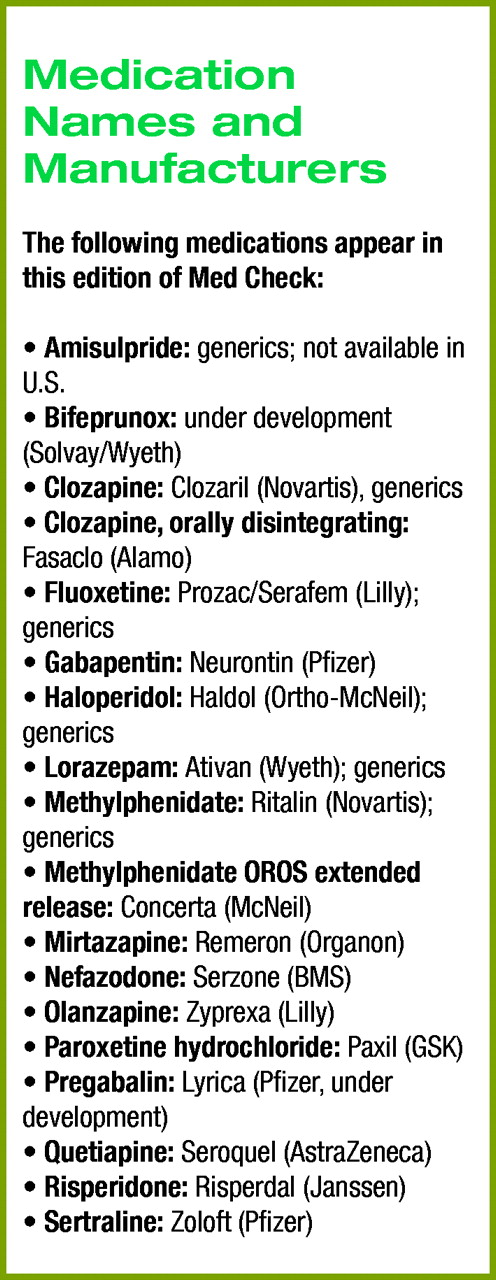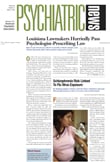Regulatory and Legal Briefs
• Fasaclo, an orally disintegrating form of the second-generation antipsychotic clozapine, received final approval from the Food and Drug Administration (FDA) in March for the management of severely ill patients with schizophrenia who fail to respond adequately to standard drug treatment. Alamo Pharmaceuticals licensed the CIMA Labs’ OraSolv technology to create a dosage form of clozapine that dissolves quickly in the mouth without chewing or swallowing. This offers an alternative for patients who have difficulty with or are unable to take standard tablets.
• Methylphenidate OROS extended release was deemed “approvable” by the FDA for daily dosing up to 72 mg. Increasing the dosing range will allow flexibility for patients who do not respond optimally at the currently approved maximum dose of 54 mg. However, because there will be no 72 mg tablet manufactured, the new higher dose will have to be given as two 36 mg tablets each morning. Final FDA approval is contingent upon submission of final labeling and additional analysis of existing data requested by the agency.
• A “Dear Healthcare Provider” (DHP) letter regarding risperidone contains “false or misleading” information and is in violations of the drug marketing, advertising, and communications provisions of the Federal Food, Drug, and Cosmetic Act, according to an FDA warning letter to Janssen Pharmaceutica, maker of the Risperdal brand of risperidone. The FDA said that the DHP letter fails to disclose new information the agency required in the drug’s labeling regarding the risk of diabetes, minimizes the risk of hyperglycemia-related events, fails to recommend regular glucose control monitoring, and misleadingly claims that Risperdal is safer than other atypical antipsychotics. The FDA has ordered the company to “disseminate accurate and complete information” to those who received the letter. Psychiatric News was unable to contact a Janssen spokesperson for comment by press time.
• The FDA’s “failure” to pull nefazodone from the U.S. market “is grossly negligent” and “continues to put countless patients at risk of death or serious injury,” according to a civil suit against the agency by the advocacy group Public Citizen. Public Citizen filed a petition with the agency over a year ago asking it to review the safety profile of the drug and strongly urged that the drug be removed from the market.
In its March 2003 petition, Public Citizen cited 21 cases of liver failure and 11 deaths associated with the antidepressant between 1994 and 2002. An updated analysis says there were an additional 33 reports of liver failure in the last year and a half, including another nine deaths. The suit asks the court to compel the agency to act in the interest of public safety and remove nefazodone from the market.
Research Briefs
• Sertraline and paroxetine appear to be associated with roughly equivalent improvement in patients with panic disorder; however, sertraline is better tolerated and associated with significantly less worsening during tapering and withdrawal of the medication. A randomized, double-blind, 12-week trial compared the two drugs in patients with panic disorder, with or without agoraphobia. After 12 weeks of flexible dosing, patients were tapered over three weeks to no medication.
Both medications were associated with equivalent improvements on the Clinical Global Impressions–Improvement Scale and the Panic and Agoraphobia Scale. During the tapering phase, however, patients who had taken paroxetine worsened, while patients who had been taking sertraline continued to improve. A higher number of patients stopped taking paroxetine than sertraline due to adverse events, and a significantly larger number of patients on paroxetine showed more than a 7 percent increase in weight over the 12 weeks.
J Clin Psychiatry2004; 65:405-413
• Mirtazapine appears to be associated with reduced use of anxiolytic medications in elderly patients with depression in long-term-care facilities. A retrospective chart review of nursing home patients older than 65 collected data on patients who were receiving newer antidepressants (SSRIs, NRIs, SNRIs, atypicals) for at least three months. Patients taking mirtazapine had lower body weight and were significantly less likely to be taking an anxiolytic medication (most notably, lorazepam). The results are consistent with mirtazapine’s strong antagonism of both the 5-HT2 and 5-HT3 receptors, which results in a relative boost in 5-HT1A action, giving it anxiolytic properties.
J Am Med Dir Assoc2004; 5:101-106
• Clozapine significantly improves all five domains within the Positive and Negative Syndrome Scale (PANSS) in patients with treatment-resistant schizophrenia. In a randomized, double-blind, 14-week clinical trial, clozapine was compared with olanzapine, risperidone, and haloperidol. Clozapine, olanzapine, and risperidone were associated with significant improvements in the positive, cognitive, and depression/anxiety factors of the PANSS. In addition, patients taking clozapine and olanzapine improved their scores on the negative factor, but only those taking clozapine showed significant improvement on the excitement factor. In contrast, those on haloperidol showed no statistically significant improvement on the positive factor and significant worsening in the negative factor, while the other factors were associated with minimal improvement with haloperidol.
J Clin Psychiatry2004; 65:551-556
• Second-generation antipsychotics have been observed to have differing effects on cognitive performance in patients with schizophrenia. The difference may be tied to how tightly each drug binds with a patient’s 5HT-2A receptors. A six-week trial compared patients on “high-affinity” drugs (clozapine, olanzapine, and risperidone) with patients taking drugs with low affinity of the receptor (quetiapine and amisulpride). Patients were tested on a broad range of neuropsychological measures at nine months and at 18 months. The high-affinity group showed a significant decrement in performance on tests of visual-recognition memory and planning ability, while those taking low-affinity antipsychotics showed improvements on these as well as other measures.
Int J Neuroscience2004; 114: 593-611
• Pregabalin appears to be a safe and effective treatment for social anxiety disorder. In March it received an approval recommendation from a European advisory commission, and it is under review by the FDA.
Pregabalin, a successor to gabapentin, is a GABA analogue that appears to modulate inhibition of neuronal excitability in the peripheral and central nervous systems. In development for many years, it may have wide clinical applicability, including as an anxiolytic, anticonvulsive, and analgesic.
The drug’s safety and efficacy for social anxiety disorder were studied in 135 patients randomly assigned to receive pregabalin 150 mg, pregabalin 600 mg, or placebo. Pregabalin 150 mg was not associated with statistically significant reductions in scores on the Liebowitz Social Anxiety Scale, compared with placebo. Pregabalin 600 mg was associated with a 70 percent improvement in anxiety scores, compared with both placebo and pregabalin 150 mg.
J Clin Psychopharmacol2004; 24:141-149
• Zinc appears to boost the effectiveness of stimulants in treating attention-deficit/hyperactivity disorder (ADHD). An Iranian study followed 44 children with ADHD who had taken no medication for the disorder prior to entering the study. Over six weeks, subjects were given standardized doses of methylphenidate. In addition, half randomly received 55 mg zinc sulphate, and half received a placebo.
Those taking methylphenidate plus zinc sulphate saw more improvement in their symptoms over a shorter period compared with those who got the drug and placebo.
Patients taking zinc were three times more likely to report nausea, but there were no other differences in reported side effects between the groups.
BMC Psychiatry2004; 4:8
• Fluoxetine appears to improve symptoms in patients with bulimia nervosa. In contrast, a study of 91 female patients in two primary care settings indicates that treating bulimia patients in primary care is significantly hampered by a high rate of discontinuation. A guided self-help tool, based on cognitive-behavioral therapy, appeared to be ineffective, while patients on fluoxetine reported greater reductions in binge eating and vomiting. In addition, those on medication exhibited a greater improvement in their psychological symptoms and attended more physician visits.
Am J Psychiatry2004; 161:556-561
• Newer second-generation antipsychotics may be effective in lowering the risk of violent behavior in patients with schizophrenia. A two-year study of 229 patients with schizophrenia found that patients who consistently took a newer medication had less than one-third the incidence of getting into fights or engaging in violent actions toward others, compared with patients who consistently took an older, first-generation antipsychotic. Data were from the North Carolina site of the NIMH’s Schizophrenia Care and Assessment Program, which is assessing clinical, functional, and service-utilization outcomes associated with routine care for persons with schizophrenia under “real-world” conditions.
Schizophr Bull April/May 2004

